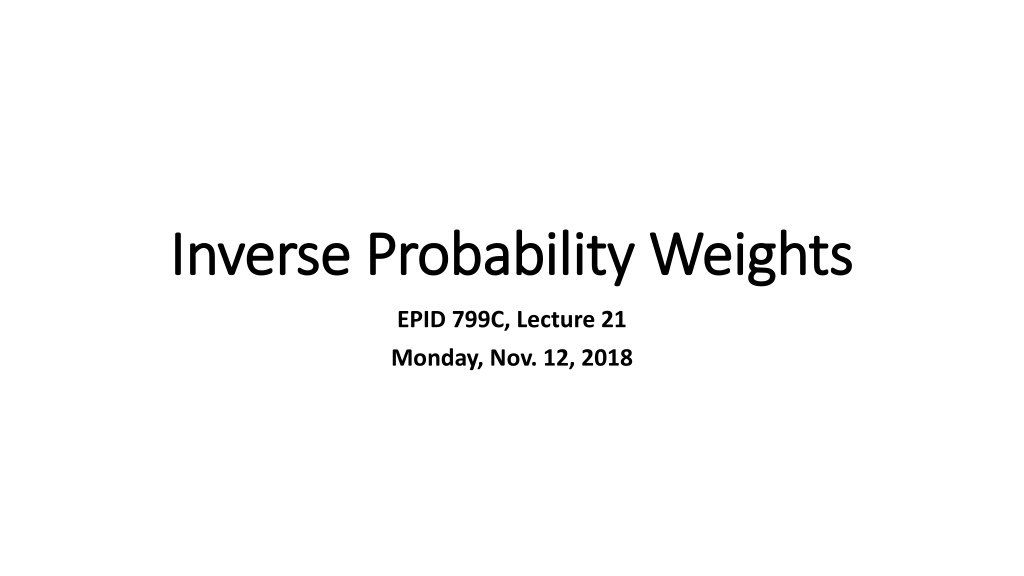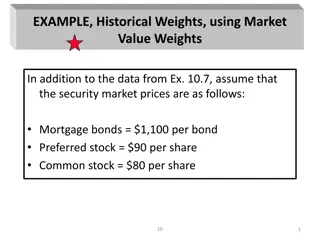Understanding Inverse Probability Weights in Epidemiological Analyses
In epidemiological analyses, inverse probability weights play a crucial role in addressing issues such as sampling, confounding, missingness, and censoring. By reshaping the data through up-weighting or down-weighting observations based on probabilities, biases can be mitigated effectively. Different types of inverse probability weights like IPSW, IPTW, IPOW, and IPCW are utilized to tackle specific issues in research. These weights are calculated based on the probability of various factors like selection into the study population, receipt of treatment, observation at a visit, and remaining under observation. Understanding and correctly applying these weights are essential for robust epidemiological studies.
Download Presentation

Please find below an Image/Link to download the presentation.
The content on the website is provided AS IS for your information and personal use only. It may not be sold, licensed, or shared on other websites without obtaining consent from the author. Download presentation by click this link. If you encounter any issues during the download, it is possible that the publisher has removed the file from their server.
E N D
Presentation Transcript
Inverse Probability Weights Inverse Probability Weights EPID 799C, Lecture 21 Monday, Nov. 12, 2018
Acknowledgements Acknowledgements Brian Pence (EPID 718) Alan Brookhart and Steve Cole (EPID 722) Mike and Nick!
Intro to IP Weights Intro to IP Weights In epidemiological analyses, weights can address a range of issues such as: Sampling / selection Confounding Missingness Censoring Think about weights as reshaping your data: up-weight or down-weight observations with the goal of removing a particular bias.
Intro to IP Weights Intro to IP Weights Weights are calculated based on the probability of: Selection into the study population Address sampling bias or generalizability Receipt of a treatment or exposure Address confounding Observation at a visit Address missingness Remaining under observation Address censoring Weight = 1/Probability Hence, inverse probability
Intro to IP Weights Intro to IP Weights To address this issue use the probability of to apply these weights Sampling / Selection Selection into the study population IPSW Confounding Missingness Receipt of a treatment or exposure Observation at a visit IPTW IPOW Censoring Remaining under observation IPCW
Todays Focus Today s Focus To address this issue use the probability of to apply these weights Sampling / Selection Selection into the study population IPSW Confounding Missingness Receipt of a treatment or exposure Observation at a visit IPTW IPOW Censoring Remaining under observation IPCW
Discuss on Wed Discuss on Wed (in context of survival analysis) (in context of survival analysis) To address this issue use the probability of to apply these weights Sampling / Selection Selection into the study population IPSW Confounding Missingness Receipt of a treatment or exposure Observation at a visit IPTW IPOW Censoring Remaining under observation IPCW
IP Weights in R IP Weights in R Disclaimer: I m still new to this, too! By hand best way for me to learn. Simple step-by-step approach. Probably at the expense of efficiency. Packages can implement more sophisticated and efficient approaches. ipw for IPTW, IPCW Alan Brookhart s work in progress ipwrisk So far, just use to check my work but could be used exclusively.
Intuition from Sampling Weights (IPSW) Intuition from Sampling Weights (IPSW) Study population: Our analysis sample. Target population: The population about whom we want to infer results from our analysis. Study population Sample may not be a perfect representation of the population. Potentially due to: not randomly selected, use of cluster sampling or stratification, systematic differences in likelihood of study participation. IPSW allows us to make inferences based on a sample that does not look exactly like the population from which it was drawn. Target population:
IPSW Example: Influenza among Older Adults IPSW Example: Influenza among Older Adults Simulated data set to demonstrate weighting approaches (will be used in EPID 718). Estimate the effect of influenza vaccination on influenza infection among adults aged 65 and older in the US during the 2016-2017 flu season.
IPSW Example: Influenza among Older Adults IPSW Example: Influenza among Older Adults Study population n=20,000 identified in Medicare claims. Stratified by age yielding the following distribution: Age range 65-69 70-74 75-79 80-84 85 Total Sample 4,000 4,018 4,000 3,912 4,070 20,000
Study Population vs. Target Population Study Population vs. Target Population How does the age distribution of our study population compare to the age distribution of the US adult population aged 65 years? Age Distribution of the US Adult Population 65 Years, 2016* 65-69 70-74 75-79 80-84 85 * Source: US Census Bureau 16,820,083 11,810,247 8,367,895 5,865,639 6,380,331
R Markdown Example R Markdown Example Are influenza vaccination and infection associated with age group? If so, how should we account for differing age distributions to infer results to the target population? Sampling weights (IPSW).
Inverse Probability of Treatment Weights (IPTW) Inverse Probability of Treatment Weights (IPTW) Goal of IPTW is to control confounding: the systematic differences between exposure groups that are associated with the outcome of interest. Confounder Outcome Treatment
Inverse Probability of Treatment Weights (IPTW) Inverse Probability of Treatment Weights (IPTW) Goal of IPTW is to control confounding: the systematic differences between exposure groups that are associated with the outcome of interest. Confounder Outcome Treatment IPTW creates a pseudo-population in which the treatment is independent of the measured confounders.
Overview of Propensity Scores Overview of Propensity Scores The propensity score is the probability of receiving your observed treatment, given the observed confounders. Propensity scores are estimated using a predictive model of treatment, as a function of the confounders. For each participant, you use this model to compute a predicted probability of receiving treatment (a.k.a., the propensity score).
IPTW using Propensity Scores IPTW using Propensity Scores The propensity score (PS) is used to calculate each participant s weight: For treated/exposed patients: weight = 1 / PS For untreated/unexposed patients: weight = 1 / (1-PS)
Apply IPTW Apply IPTW Fit a standard regression model for the exposure-outcome relationship, but using the weighted observations. Estimates the average effect of treatment in the population. Average risk of outcome if everyone had been treated vs. average risk of outcome if nobody had been treated. Weights can be stabilized to improve efficiency. Need to account for weights in estimating standard error.
R Markdown Example R Markdown Example Using the births data, estimate a propensity score model for the probability of receiving early prenatal care as a function of confounders. Calculate IPTW based on the propensity score model. Apply IPTW to estimate the weighted association between early prenatal care and preterm birth.
Using IPTW for Marginal Structural Models Using IPTW for Marginal Structural Models Time-varying exposures are often of interest: Births data: Time-varying attendance of prenatal care visits. My dissertation: Time-varying depressive symptoms. Time-varying covariates may be both confounders and intermediates: Predictors of the exposure and outcome (confounders). Affected by history of exposure (intermediates).
Confounder Outcome Treatment
Time 0 Time 2 Time 4 Covariate Covariate Covariate Treatment Outcome Time 5 Treatment Time 1 Time 3
Using IPTW for Marginal Structural Models Using IPTW for Marginal Structural Models Model for the marginal distribution of the potential outcomes. We only see your potential outcome under treatment or no treatment. Causal contrast: always treated vs. never treated. Fit a marginal structural model using IPTW: Propensity score model for the probability of treatment (A) as a function of time-fixed confounders (C), time-varying confounders (Z) and previous A. ???? ?? ~ ? + ?? 1 + ?? 1 Use propensity score to calculate IPTW. Estimate casual effect in the weighted population: ???? ??+1 ~ ??
R Markdown Example R Markdown Example Using my dissertation data: 455 HIV-positive people who inject drugs (PWID) in Vietnam, followed for 2 years with study visits every 6 months. Example analysis: What is the effect of depressive symptoms on injecting risk behaviors? Use IPTW for marginal structural model, given time-varying exposure and confounders.























